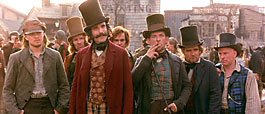 Gangs of New York appears in an aspect ratio of approximately 2.35:1 on these single-sided, double-layered DVDs; the image has been enhanced for 16X9 televisions. The decision to spread the 167-minute Gangs across two discs surprised and irritated many. Had this resulted in a stunning visual presentation, I’d support it. Unfortunately, Gangs never appeared to capitalize on this, as it suffered from more flaws than I expected.
Gangs of New York appears in an aspect ratio of approximately 2.35:1 on these single-sided, double-layered DVDs; the image has been enhanced for 16X9 televisions. The decision to spread the 167-minute Gangs across two discs surprised and irritated many. Had this resulted in a stunning visual presentation, I’d support it. Unfortunately, Gangs never appeared to capitalize on this, as it suffered from more flaws than I expected.
Sharpness caused most of the concerns, largely due to the presence of some occasionally intrusive edge enhancement. Haloes popped up sporadically and didn’t create a constant issue, but they interfered with more than a few scenes. This rendered some wide shots in a mildly blurry manner. Most of the time the movie remained detailed and well defined, but a little too much of it appeared slightly soft. No issues related to jagged edges or moiré effects appeared, however.
As for print flaws, a smattering of those showed up throughout the movie. Though a few bits of grit appeared, mostly I noticed examples of white specks. These certainly weren’t heavy, and they showed up pretty infrequently. However, given the recent release date and “major motion picture” nature of the project, I thought the DVD displayed too many of these defects.
On the positive side, colors seemed terrific. Other than a few stylistic desaturated sequences – such as the opening fight – the movie mostly displayed rich and warm hues. The tones were deep and lively without any signs of noise or messiness. Black levels also came across as dense and tight, while shadows were clean and accurately delineated. Much of Gangs looked excellent, but enough of the image created problems that I didn’t think it earned better than a “B-“ given the vintage and prominence of the project.
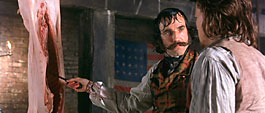 The film’s audio seemed somewhat more successful, but those elements still weren’t great. Gangs of New York boasted both Dolby Digital 5.1 and DTS 5.1 mixes. I thought the pair seemed virtually identical. At no point did I detect any substantial differences between them.
The film’s audio seemed somewhat more successful, but those elements still weren’t great. Gangs of New York boasted both Dolby Digital 5.1 and DTS 5.1 mixes. I thought the pair seemed virtually identical. At no point did I detect any substantial differences between them.
As a character-driven drama, the soundfield often remained pretty subdued. Much of the time the track simply bolstered events with general atmosphere. Music presented good imaging, and the track created a nice feeling of environment. When pushed, however, it became more involving. The best parts popped up during the film’s climactic riot sequence, especially when the military became involved. In addition to gunfire, the track presented excellent movement of cannon blasts. The surrounds strongly entered the picture here and during other set pieces, and effects such as the soaring cannonballs worked quite well.
Unfortunately, the quality of the audio appeared somewhat erratic, with most of the problems present during the film’s first act. Within that time span, both the Dolby and DTS tracks suffered from a few elements that featured excessive reverb. From DiCaprio’s narration to foley effects to the voices of extras, some parts of the track sounded distant and featured too much echo. For example, check out the scene with the competing fire fighters; so much reverb popped up that the whole thing came across as staged and fake.
Happily, these issues essentially evaporated after a little while, and the rest of the audio seemed satisfying. Outside of the aforementioned bits, speech sounded natural and distinct. I noticed no issues related to the speaking of lines, and effects also failed to present any concerns. Those elements appeared accurate and tight, and they also featured pretty solid bass response when appropriate. The cannon blasts provided the film’s sonic highlights, but other parts of the film also woke up my subwoofer in a satisfying way. The score seemed nicely clear and robust as well. Ultimately, the audio of Gangs of New York was pretty good, but the smattering of flaws knocked down my grade to a “B”.
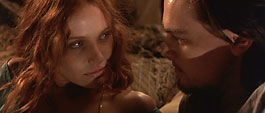 This two-DVD edition of Gangs tosses in a nice mix of extras. Most are specific to the individual platters, but an audio commentary from director Martin Scorsese spreads across both. Though not obviously edited, this track also didn’t sound like a running affair, as it appeared to come from an interview. It definitely failed to become screen-specific, as I recall no instances during which Scorsese actually remarked directly upon the action.
This two-DVD edition of Gangs tosses in a nice mix of extras. Most are specific to the individual platters, but an audio commentary from director Martin Scorsese spreads across both. Though not obviously edited, this track also didn’t sound like a running affair, as it appeared to come from an interview. It definitely failed to become screen-specific, as I recall no instances during which Scorsese actually remarked directly upon the action.
Nonetheless, the director offered a very good chat that related to the film. He mostly covered the history behind the movie as he told us about the times and facts of the era. In addition, we learned about the film’s long path to the screen, casting, the visual style, music, sets, costumes and other production elements. He even told an interesting tale about how he originally wanted the Clash to do the music back when he initiated the project in the Seventies. Despite a few moderate empty spaces, this commentary provides a solid examination of the flick.
After this we find a series of video programs. The nine-minute and six-second Set Design featurette presents some movie images, footage from the set and production art, and interviews. We get remarks from production designer Dante Ferretti, Scorsese, cinematographer Michael Ballhaus, second unit director Vic Armstrong, and actors Daniel Day-Lewis, Cameron Diaz, Jim Broadbent, Leonardo DiCaprio, Gary Lewis, Liam Neeson, John C. Reilly, and Brendan Gleeson. A pretty basic program, Ferretti gives us a little decent information about the creation of the film’s sets and its look, but too much of it comes across as fluffy. We hear many comments from the participants about how great the sets were but not much depth.
A companion piece, Exploring the Sets of Gangs of New York lasts 22 minutes and 30 seconds. We watch Scorsese and Ferretti as they stroll through the sets. They offer comments about the work, the movie, and the factual basis behind them. We learn lots of nice details about the sets and get a fine look at them in this interesting little program.
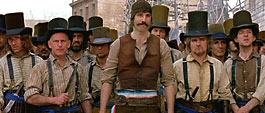 “Exploring” can be viewed with or without “360-degree pop-ups”. With that feature activated, you’ll occasionally get the chance to hit “enter” on your remote and watch a 360-degree illustration of the set in question. I think the footage in the program proper displays them well enough to make this feature somewhat redundant, but it’s a good addition for those who want to see as much of the sets as possible.
“Exploring” can be viewed with or without “360-degree pop-ups”. With that feature activated, you’ll occasionally get the chance to hit “enter” on your remote and watch a 360-degree illustration of the set in question. I think the footage in the program proper displays them well enough to make this feature somewhat redundant, but it’s a good addition for those who want to see as much of the sets as possible.
The eight-minute and 11-second Costume Design resembles “Set Design” in its construction. Here we find remarks from Scorsese, costume designer Sandy Powell, wardrobe supervisor Paolo Stefano Scalabrino, and actors Liam Neeson, Day-Lewis, and Diaz. They cover the historical details and liberties as well as other considerations involved with the costumes. “Costume” seems much more compelling than “Set”, as it includes substantially greater levels of actual information and doesn’t just praise the designers’ work.
Next we find a History of the Five Points. This 13-minute and 35-second program features the usual movie clips, behind the scenes tidbits, and interviews. We discover statements from Scorsese, author/historical advisor Luc Sante, and actors DiCaprio, Neeson, and Broadbent. Sante dominates the piece as he leads us through a quick glimpse at the facts behind the film. Some of this appears elsewhere, but we get some new information, and “History” feels like a tight and useful piece as a whole.
For more material in the same vein, we go to the Five Points Study Guide. The “Luc Sante Introduction” gives us a very good text overview of the historical information. The “Five Points Vocabulary” provides definitions for terms heard in the movie. Both combined help flesh out their subjects neatly.
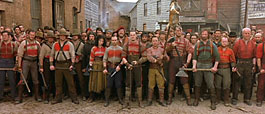 DVD One concludes with a mix of ads. We get both the teaser and theatrical trailers for Gangs as well as promos in the Sneak Peeks domain. There we find trailers for Frida, Kill Bill, The Quiet American, Confessions of a Dangerous Mind, Chicago and A Personal Journey with Martin Scorsese.
DVD One concludes with a mix of ads. We get both the teaser and theatrical trailers for Gangs as well as promos in the Sneak Peeks domain. There we find trailers for Frida, Kill Bill, The Quiet American, Confessions of a Dangerous Mind, Chicago and A Personal Journey with Martin Scorsese.
On DVD Two, we locate two features. The first offers a Discovery Channel special called Uncovering the Real Gangs of New York. This 35-minute and 11-second program includes a few movie clips, many historical items, and interviews with Kenneth T. Jackson of the New York Historical Society, archaeologist Rebecca Yamin, Ruth Abram of the Lower East Side Tenement Museum, anthropologist Brian Ferguson, authors Luc Sante, Tyler Anbinder and Peter Quinn, actors Daniel Day-Lewis, Cameron Diaz, and Liam Neeson, and director Scorsese.
Though the appearance of the film folk made me worry that “Uncovering” would offer little more than a puffy promotional piece, instead it gives us a nice examination of the facts behind the movie. The participants trace the history of pretty much everything we see in the flick. There’s information about real-life counterparts to characters as well as notes about the evolution of the Five Points, the various riots and other legal issues, and many other topics. This program moves briskly as it concisely relates the material. It’s a fine piece that I wish I’d watched before I saw the movie; knowing these details enhances the film.
Lastly, we get the music video for U2’s “The Hands That Built America”. Not identical to the clip that appears on the band’s The Best Of 1990-2000, this one uses the same footage of the band in the studio, but tints it to offer an old-timey look and intercuts it with movie footage. The Best Of edition isn’t very good, but this one’s even worse. I adore U2, but this is a cheesy video.
Gangs of New York won’t go down as Martin Scorsese’s worst film, but it also falls far from the top of his work. The movie presents a handful of enthralling sequences but suffers from a weak script, a messy third act, and a mix of other problems that undercut its strengths. The DVD displays generally good but erratic picture and sound plus a nice roster of supplements enhanced by a good commentary from the director. Enough of Gangs seems compelling for me to recommend a rental, but don’t expect a whole lot from this flick.

